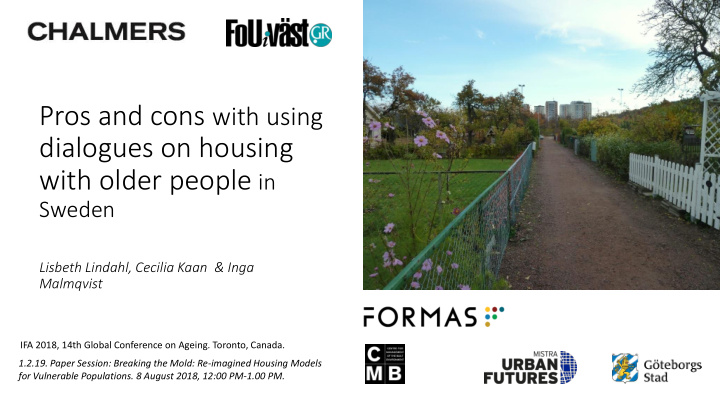



Pros and cons with using dialogues on housing with older people in Sweden Lisbeth Lindahl, Cecilia Kaan & Inga Malmqvist IFA 2018, 14th Global Conference on Ageing. Toronto, Canada. 1.2.19. Paper Session: Breaking the Mold: Re-imagined Housing Models for Vulnerable Populations. 8 August 2018, 12:00 PM-1.00 PM.
How do older people live in Sweden? • 20 % of the population are 65+ (80+ is growing fast). • Sweden has one of the most developed welfare system in the world, including elderly care • The majority of old older people le liv live in in hou ousin ing on on th the or ordin inary ry mar arket (95 %) • Three types of housing for elderly: • Ordin inary hou ousin ing: Detached houses, semi- detached houses or apartments • In In between hou ousin ing: Senior housing, extra-care housing, cohousing for seniors. • Resid idential care/nursin ing hom omes: Older people Picture: Wikimedia commons with dementia or severe functional limitations/health problems, needs assessment.
What does dialogues mean? • Dia ialo logue: : Th The opposit ite to monolo logue “A discussion between two or more people or groups, especially one directed towards exploration of a particular subject or resolution of a problem.” (Oxford dictionary) • Rela lated to partic icip ipatio ion (Arnstein, Castell) • Dif ifferent ty types of of dia ialo logues about th the neig ighborhood/ / housin ing envi vironment: • Citizen dialogues (held by the municpality) • Design dialogues (held by architects, construction clients etc.) • Dialogues between the landlord and the tenants
Arnstein’s ladder and Castell’s stairs Sherry Arnstein 1969, Degree of citizen participation . Pål Castell (2013), Stegen och trappan (The ladder and the stairs).
Why use dialogues with the local community? • Citizen dialogues – democratic rights • Design dialogues – to get more knowledge about a certain group’s needs and preferences. • To create user involvement
Housing for older people is a multi-faceted area Housing for the elderly (65+) is a multi- faceted area affected by many perspectives. Due to specialization, different organizations have very specific assignments and focus on eit ither eld lderly or housing, which increase the need for dia ialogue betw tween organizations as well ll as wit ith th the cit citizens of the local community. There is a need of collaboration to reach the Illustration of the organizations involved in one of the cases where dialogues were held in the early planning goal of an age friendly environment. phases.
Ongoing research study • Four cases in in dif ifferent stages, one is not built yet. Two senior housing and two Extra-care housing. • Following/following up processes fr from th the stage of of pla lanning, g, building and aft fter th the tenants have moved in in. • Include constructions cli clients/land lo lords, architects, , tenants, civ civil servants/managers in in th the municipalities, pensioner organisations etc. • Mix ixed methods: interviews, questionnaires, observations, official documents, statistics from the landlords etc. • 2016-2019
Aim of the project The overall aim with the research project is to shed light on how to build sustainable housing for seniors and to describe the role of dialogues.
Preliminary findings • Dia ialogues are rarely used among construction clients and architects when it comes to ordinary housing. • The construction clients or architects who use dialogues do that because they want to le learn fr from po potential users (needs, preferences) and to cr create user in us involvement. • All tenants who had signed up for an apartment/or moved in wanted to to to in influence more than they were allowed to. • But, there is a dil ilemma between using dia dialogues/give th the po power to th the tenants or not.
Consequences of using or not using dialogues • In one case, the tenants had the possibility to in influence th the common space for social act ctivities after one year. A majority wanted it to be closed (to reduce the rent). However, some of the tenants wanted to keep it. • In another case, th the dia ialogues in in th the early phases of f th the pla planning pr processes were de devalued du due to severe de delay of the project. This might jeopardize the trust from the local community in the future. • Interviews with tenants who had not been involved in dialogue, reveal features th that are not age fr friendly. Such errors might have been A cupboard that is not easy to reduced if dialogues would have been used. use for older persons.
Reflections • There seems to be mor ore e adv advantages than disadvantages with using dialogues. • Actors who invite older people to participate in dialogues should be aware of of the the limit itatio ions of of usin using dia dialogues. • Dialogues should inclu lude the the ne needs of of mor ore e vu vuln lnerable le group oups to create age-friendly housing for all older people (vulnerable groups cannot always participate). • It is important to inform the participants about the aim aim of the dialogues, how the their ir con ontrib ibutio ion will be considered, and if f a a bui build ldin ing pr proj oject is s de dela layed to create trustworthy relationships. • A limitation with dialogues is that they do not cover the pr prer erequis isit ites and and pr preferences of of old older pe people in in the the futu future. The buildings will last for 50 to 100 years and should be built with flexibility to different needs in the future.
Thanks for listening! lisbeth.lindahl@grkom.se
Recommend
More recommend